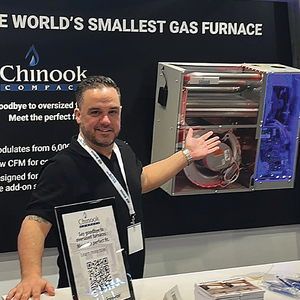How Efficient Are Heat Pumps, Really?
Heat pumps have higher efficiencies than systems that rely on fossil fuels, but the cost of electricity and fuel drives the decision.

We’re building a detached garage with an in-law apartment above it. We’re uncertain how to heat and cool it, but we’re hearing a lot about minisplit heat pumps, and wondering if they are really more energy efficient (and cheaper to run) than standard fuel-burning heating equipment. Are they?
—Amanda via email
Former Green Building Advisor editor Martin Holladay replies: In this context, efficiency is a measure of the amount of heat energy that is delivered to the house as a percentage of the energy consumed by the heating appliance. A furnace or boiler that burns fossil fuel (natural gas, propane, or heating oil) will have an efficiency that ranges from about 78% to 98%. In the case of a heat pump, the fuel is electricity. A toaster or electric baseboard heat has an efficiency of 100%. A heat pump has a higher efficiency— usually in the range of 200% to 300%, although higher efficiencies are possible, especially for well designed ground-source heat-pump systems. (Note that well-designed ground-source heat-pump systems are rare.)
The reason that a heat pump can have an efficiency greater than 100% is because most of the delivered heat is collected from the outdoor air. The heat pump absorbs heat from the outdoor air, and delivers the collected heat to the house. (A small percent- age of the delivered heat consists of waste heat from the system’s fans.)
Homeowners choosing between an air- source heat pump (for example, a duct-less minisplit) and a fuel-burning furnace rarely care about the relative efficiency of the two approaches. The fact that a heat pump has an efficiency of 250% and a furnace has an efficiency of 92% doesn’t tell you much. Most homeowners care about the relative cost of the two approaches, not the efficiency numbers. In the U.S., heat from an air-source heat pump is usually cheaper than heat from a furnace that burns propane or oil, but more expensive than heat from a furnace that burns natural gas. There are exceptions to this generalization, however. The lower your cost of electricity, the more attractive a heat pump is from a financial standpoint.
Finally, some homeowners don’t care about efficiency or cost—they care about their carbon footprint. If you’re that type of homeowner, note that an air-source heat pump has a low carbon footprint in areas of the country (like the Pacific Northwest) with an electricity grid that depends largely on hydroelectricity or other renewables, but has a relatively high carbon footprint in areas of the country (like West Virginia) with an electricity grid that depends on coal.
From Fine Homebuilding #291
More about heat pumps:
High-Performance HVAC – Ductless minisplit heat pumps are becoming the go-to choice for heating and cooling in well-insulated, tight houses.
Minisplit Heat Pumps Efficiently Heat and Cool this House – Three indoor units provide the right mix of comfort and efficiency for this well-insulated but complex floor plan.
Webinar: Heat Pumps and Cold-Climate Applications – Designing for Comfort and Resiliency





























View Comments
There's a big difference between efficiency ratings and actual energy costs. For example, electric resistance heat such as baseboard heater is 100% efficient, yet it requires high energy demand and is one of the most expensive ways to heat.